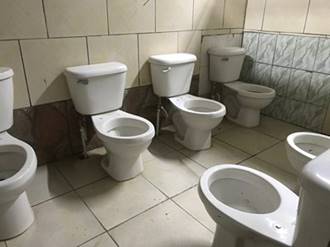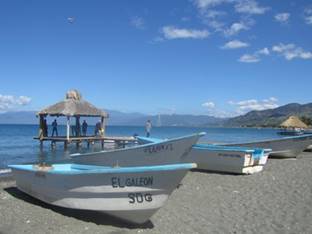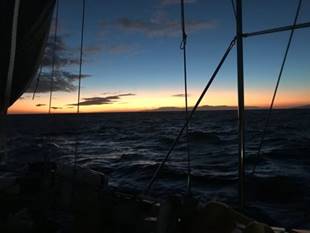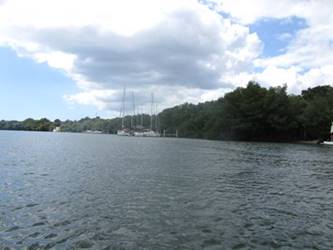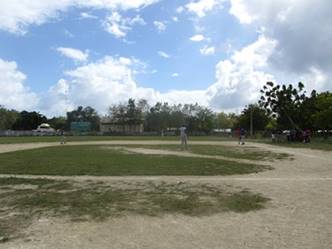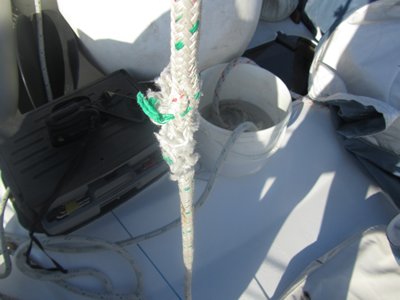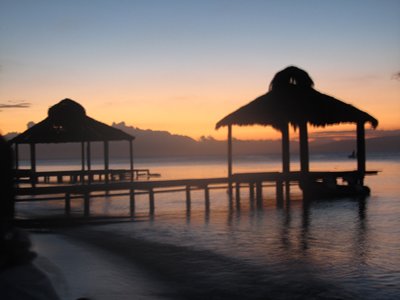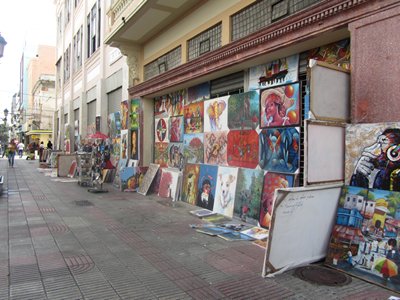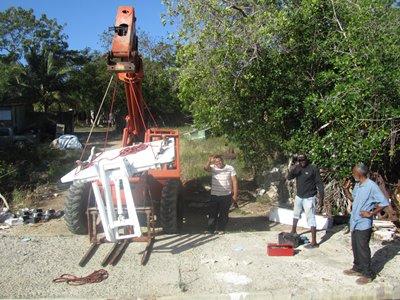Dominican Republic - January/February 2018

Hispaniola, Greater Antilles – January, February 2018 Dominican Republic Monday 29 January 2018: Ile a Vache (Haiti) to Barahona (Dominican Republic), 212 miles, 43.75 hours, 29.8 engine hours, 4.84 knots average speed. Total miles since leaving Falmouth in August 2016: 9900.4 We had been warned that some of the officials in the Dominican Republic (DR) requested, even demanded, rum and beer as well as cash, as tips. Having stocked up with small bottles of said items we departed Ile a Vache at 1500 hrs in order to arrive in DR during daylight hours the following day. As expected the wind was coming from the East (the trade winds) – not good for the direction we were heading, so we motor-sailed initially. We had also learned through reading various books and before deciding on the Haiti and Dominican Republic route, that if heading into the trade winds, night sailing would be advantageous with the Katabatic winds coming off the land as the cool air sinks, stalling the trade winds. Eventually able to sail, we tacked along the coast under a very bright full moon lit sky. Our VMG was pretty poor, but we were trying to conserve fuel as wanted to hold out to Puerto Rico to re-fill; cheaper than DR! We had a couple of minor breakages – nothing that couldn’t be fixed, and a major breakage. The clue (the corner of the sail where the sheets attach onto the genoa) ripped clean off. General wear and tear plus intense UV damage had weakened the stitching. This left the sail flapping with no way of pulling it in. All we could do was furl it away and back on with the engine. Luckily we have a spare sail which we would swap when safely in port.
Barahona We anchored in a sheltered basin opposite a very small dock housing just a handful of boats, most of which looked abandoned, apart from a French boat. Immediately we had secured the anchor we were boarded by Immigration, M2 (Intelligence) and the Armada (Coast Guard), oh, and Fernando who rowed them over to us and was the interpreter.
Ken put the cockpit table up for us all to sit around but they barged straight past below decks, seating themselves around the saloon table, without not so much as a ‘hola’ or buenos dias! It didn’t take them long to ask for a tip and a beer each (it wasn’t even midday). Ken had already given a $27 tip – the change from $100 for the $73 check-in fee! He offered another $5 but the Armada pushed it away in disgust. Fernando translated that another $20 was expected!! They asked if we had guns on board, which we don’t. The Coast Guard stood up, puffed his chest out and said he needed to look around, then promptly went back on deck without looking at a thing and off they went! Fernando arranged for a driver to take us to the supermarket, fruit and veg market, bank and filling station to fill our jerry cans – 3 hours of his time for $20 total; we were happy with that! We got chatting to the French boat on the dock, who invited us for sundowners, then to join them in town for dinner. Ken rode with the guys in the back of the pickup which gave him very big hair!! I was not impressed with the ladies toilets!
Friday 2 February: Barahona to Palmar de Ocoa, 34 miles, 7 hours, 4.3 engine hours, 4.86 knots ave. speed Total Miles: 9934.4 After another fuel run we sought out the customs and immigration office. Checking out with the officials cost another $20 in order to receive the despatcho – the document giving us permission to leave the port, that we would need to show the officials at the next port. Checking in and out of each port is a necessity in the DR (as in many other countries) and only certain ports have the authority to check you in and out of the country. It is a slow procedure due to all the information they require – from passport details to the colour of the stripe on the boat!! Their non-English and our non-Spanish only delays proceedings. However, it would not be worth the consequences not to check in and out! Palmar de Ocoa was completely different in many ways. Imagine a palm tree lined beach with colourful fishing boats and stunning mountains in the background and officials that didn’t demand beer and dollars! The commandant and coast guard were actually very friendly and gave me a coconut! The procedure still took a while due to the language barrier but we had a laugh in the process (mainly them at us trying to speak Spanish)!
We learned a valuable lesson tying our dinghy to the wooden dock; a local pointed to his eye then to the dinghy. He didn’t speak English so we gave up trying to communicate and went off to explore the village for the day. Several hours later we returned to the dinghy and was approached by the local who held one hand out for money, the other pointing from his eye to our dinghy. We tried to explain we hadn’t asked him to watch our dinghy, nevertheless gave him the only change we had, the embarrassing equivalent of 50p. Of course he was not impressed! We went off to get a beer but I couldn’t relax. Part of me felt extremely guilty, the other part concerned the local may damage the dinghy in some way or set it adrift. I asked another English speaking local how much we should have paid. He said about $8. I went back and gave him the change from our beer, about $5. He was happy with that and at least I could relax!
At sunset we watched the locals haul in a massive net onto the beach full of small fish and the women fill their buckets. The kids were darting in and out pinching the fish for bait! The insects were eating us ‘blancs’ alive so we left sharpish. On return to the boat a couple of fishermen were trying to free their net from our keel and rudder. It had swept down with the current. We leant them a mask and shone torches while they dived down to free it. No harm done!
Boca Chica was our next stop; a night sail away. 32 knots of wind on the nose initially, thankfully easing to 20. We motor-sailed to give us a better direction until the engine cut out. We think something blocked the fuel intake, that was disturbed in the tank due to the boat bouncing in the choppy seas. Fortunately we were able to bleed it and it started. The authorities surprisingly didn’t rip us off checking us in – we had heard some dreadful reports of people being illegally charged astronomical amounts ($300!). They don’t permit anchoring, so obtained money from us through marina fees! A very nice marina it was too!
Boca Chica: a scooter ride to a very run down town full of prostitutes, scooters zipping about and a bustling beach with lots of shack eateries and loud music. Not my favourite place. It was good to be back in the confines of the ‘posh’ marina, having had a road side meal, the whole evening costing us $7, including scooter fare! Two buses took us to Santo Domingo, the capital of DR. The old town, zona colonial, was spectacular with its 15th century buildings, clean streets, art stalls and smart restaurants. Well worth the visit.
Mistake number two in DR was walking back to the bus terminal instead of taking the recommended taxi. I heard someone shouting “amigo, amigo”. Thinking it was someone after money or trying to sell us something we continued on. The shouting also continued. Three local guys were shouting and waving from a balcony, then we noticed someone running after us also waving. We stopped and the local explained we were walking into the rough part of town and would likely be shot and robbed. He kindly walked us a good 20 minutes to the bus terminal, through a very grim looking area where we were stared at feeling very uneasy, but he didn’t ask for anything in return and insured we were safely on the bus. We were very relieved and of course gave him a tip to show our appreciation! Checking out the next day caused issues. A person at the marina office tried to charge $20 to organise our despatcho. Ken was not pleased as we had already paid our entry fees into the country and should not have to pay more until leaving the country. He strongly voiced his opinion explaining how DR had a bad reputation and people were very put off visiting for this very reason. Fortunately the very nice dock master diffused the situation and gave Ken a lift to the port office to drop off our passports and paperwork. Customs, Immigration and M2 came to inspect the boat, returned our passports and issued a despatcho, at no extra cost! We were on our way. Cumayasa River was our next anchorage, 30 miles along the coast. The almost hidden river was very well protected from the choppy seas, the odd house dotted amongst the trees with private dock and eagles circling above. Further up the river was a small dock with a handful of boats, but no others anchored. The uniformed officials, Marina (Navy) and M2 (Intelligence) came out immediately to check our paperwork. They were very welcoming and demanded nothing! A refreshing change.
Getting into the dinghy to go ashore we noticed the platform it sits on had developed cracks in the aluminium welding, probably due to the continual bouncy seas. We would need to get this seen to immediately as couldn’t risk the weld failing completely. We were not keen on towing the dinghy with the waves being so big and the risk of it flipping over with its heavy irremovable outboard motor. Ashore consisted of a couple of tiny colmados (grocery shacks), a baseball pitch, a bar being renovated, a few houses, the navy building and a boat yard!
The boatyard solely built and repaired catamarans for the tourist industry. We persuaded the owner to have a look at the platform and being an ex-cruiser he understood our predicament and agreed to fix it. There was nobody else locally. This meant reverse mooring at a shallow dock, the bow being held by the anchor, so the platform could be removed by a crane and taken to the yard. It took a few days to fix but the cost was minimal – we were expecting approx. $700, but he charged $250 (£180) and even gave us a lift to the supermarket! The guy looking after the crumbling dock tried to charge us $60 for 3 nights. The dock had nothing, not even proper bollards to fix our lines to so we expressed it was a bit steep. He dropped his price to $50, then saw Ken didn’t have much cash in his wallet and said $40 would be fine. Most bizarre!
The facility-less dock! On to Bayahibe, just 15 miles away. The anchorage was full of large catamarans being loaded with food, drinks and tourists for a day trip to Isla Saona. It had rained on and off most days we were in DR with constant high winds, which we discovered was very unusual for the time of year. It doesn’t normally rain until April, however had rained at some point everyday throughout the winter – the first season like this for 20 years. On arrival it was raining however it soon cleared up to brilliant hot sunshine and we went ashore to check- in and hopefully get our despatcho to depart the country the following day. We were informed they were unable to issue a despatcho for us to leave the country (for Puerto Rico) and we’d have to go to Casa de Campo, 4 miles back along the coast. We were not happy about this as has heard and read on various websites the staff at Casa de Campo could be very unpleasant rip-off merchants who had even been known to plant drugs on board vessels (yikes!). We didn’t really want to enter another country without the correct paperwork and risk the boat being impounded (not sure what would happen to us?!) so we would make the trip in the morning, after going back ashore to collect our despatcho from Bayahibe to Casa de Campo first thing; (they wouldn’t issue it there and then – has to be just an hour before departure!).
Bayahibe was a great place, buzzing infact. The town was small, clean and colourful with a lovely beach and harbour. We enjoyed watching the day trippers return from their cruise, sunburned and happy! On the very rare occasions we eat out we try and find local dining and typically had a lovely meal of calamari, fish, rice and plantain, very cheaply too ($10/head (£7.20)). Unfortunately the anchorage was very rolly and Lady Rebel creaks like mad when rolling so not much sleep was had. We should be used to this by now, but no…..!
At Casa de Campo, having obtained permission by VHF radio, we moored on the fuel dock figuring if we purchased fuel they might be nicer to us! The marina complex was amazing; very upmarket. The officers arrived by golf cart to collect our passports and registration documents and couldn’t have been more friendly. They allowed us to remain on the fuel dock for the hour or so it took to prepare the despatcho, even gave us their wifi code! The coast guard and narcotics officers came aboard for a final inspection and the cost was $40, the going rate. To our amazement there was no request for rum or beer and our tip was politely declined. What a pleasant surprise. We were soon on our way with great relief and smiles on our faces making a mental note to update the various websites with favourable comments.
Next stop Puerto Rico. |










